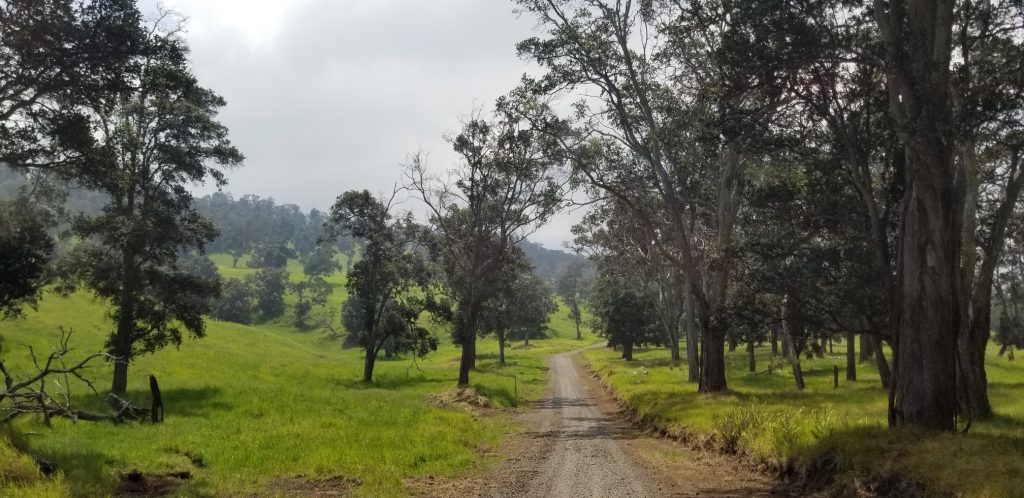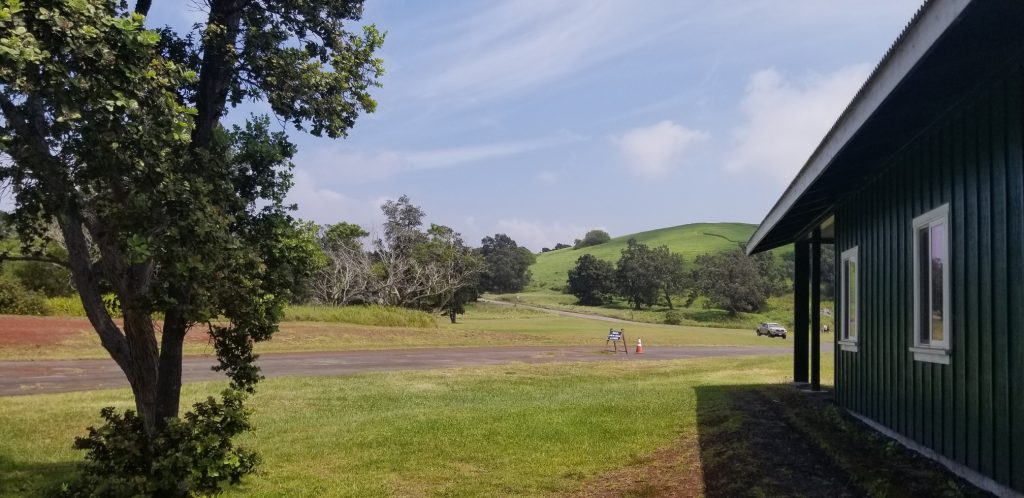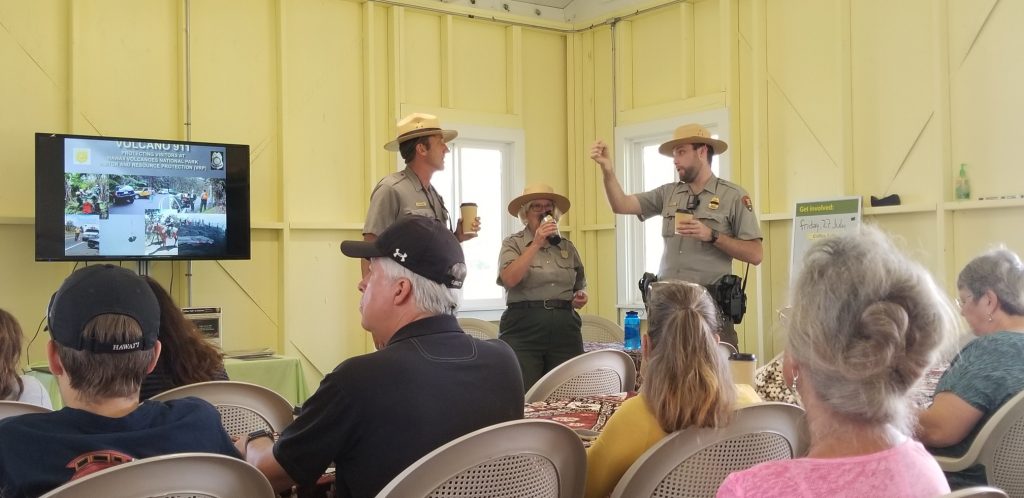
The Kahuku Unit of Hawaii Volcanoes National Park hosted a casual “Coffee Talk” session with National Park Service Law Enforcement Rangers to discuss mitigating disaster in National Parks. Both Chief Ranger John Broward, in charge of law enforcement and emergency services and Kahuku Law Enforcement Ranger Ryan Deacy described their experiences of keeping visitors safe while also providing an update of conditions inside the park. Most of Hawaii Volcanoes National Park has been closed since May 11 due to frequent and damaging earthquakes, triggered by collapse/explosion events within Halema‘uma‘u, the summit crater of Kīlauea Volcano. While the bulk of the park around Kilauea Volcano is closed, the Kahuku Unit, located roughly an hour south of the park’s now-closed main entrance, is open several days a week.
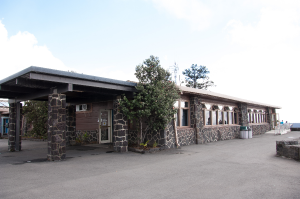
“I’m not a structural engineer, but my personal thought is that Jaggar won’t re-open, ” Broward told the audience, describing significant damage to the historic summit museum surrounded by a look-out ledge visited by millions over the years. Broward said that the ledge has major cracks and is likely to slip into the volcano’s caldera as strong earthquakes continue to rock the region. According to Broward, once the seismic activity relaxes, structural engineers will make an official assessment of park buildings and roads and determine next-steps. “My opinion, and it’s only my opinion, is they’ll need to raze the museum due to earthquake damage.” While the Jaggar Museum is in poor shape, Broward said the famed Volcano House is in better shape, adding that a seismic retrofit performed on the historic hotel seems to be helping significantly since his last visit to the property weeks ago.
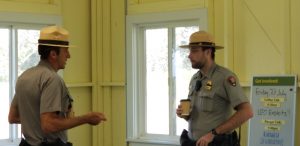
Buildings aren’t the only thing suffering from near-constant seismic activity at the volcano’s summit. Chain of Craters Road, which serves as an emergency evacuation route for the Kalapana area, is suffering from large cracks similar to those found recently on and around Highway 11 near the main park entrance. “Some cracks are tens to hundreds of feet deep or more on Chain of Craters Road, ” said Broward. “This is problematic for the emergency evacuation route.” Broward said that county, state, and even national resources will work together to resolve the damage situation on Chain of Craters Road if it were ever needed, much like those same resources are working together to keep Highway 11 open. “I can’t answer on the status of Highway 11, but I can tell you there’s lots of agencies doing everything they can to keep the highway open.” Highway 11 is the only road on the eastern side of the island that connects south Hawaiian communities of Pahala and Naalehu to northeast towns of Hilo, Pahoa, and Mountain View. Should Highway 11 completely collapse or need to be closed, people would need to take a 4-hour detour each way on the opposite side of the island to get around.
Broward said park rangers drive up/down the length of Chain of Craters Road at least once a day to check on cracks and the overall stability of the road.
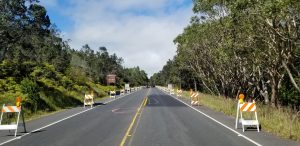
“I am confident the park will re-open, ” Broward said, although said he wasn’t sure when that would be. “In the last 30 years, every National Park that was damaged has been repaired and re-opened”, and Broward said he expects the same to happen in Hawaii over time. “We meet about three times each week to see what we can open up,” Broward said, adding that ongoing seismic activity is keeping conditions too dangerous to open up roads and trails around most of the park. “We looked at opening Mauna Loa Strip Road, but cracks on Highway 11 prevent us from doing that,” Broward said. Until Highway 11 becomes more stable, the National Park doesn’t want to bring increased traffic to the area. Due to slumping and cracks, the speed of the road has been reduced to 25 mph to allow travelers to safely navigate over steel plates and around cones and barriers; the road is also occasionally reduced to one lane of traffic to allow for repair work, inspections, or surveying.
Some of the park’s famed natural features remain undamaged. The Thurston Lava tube, a popular cave park guests have explored since its discovery in 1913 by Lorrin Thurston, a local newspaper publisher, wasn’t harmed by a potent 6.9 earthquake that rocked the island of the start of the most recent Kilauea Volcano eruption. However, because the cave hasn’t been explored since May due to ongoing seismic threats, it is possible some damage may have occurred since then. The Hōlei Sea Arch, a popular natural attraction at the bottom of Chain of Craters Road “was still there” according to Broward, relaying information shared by rangers on a recent drive-by. However, a significant crack opened nearby, threatening the feature; additional seismic activity could force the arch to collapse and fall into the sea.
The full scope of damage throughout the park is not yet fully known. While it is too soon to understand the financial cost of the damages in the park, it is also too soon to understand the overall financial impact a prolonged park closure has on Hawaii’s tourism industry. The park is big business for the island’s bustling tourism industry: according to National Park Service report released in April, 2,016,702 visitors came to Hawaii Volcanoes National Park in 2017 and spent $166 million in communities near the park. That spending supported 2,020 jobs in the local area, and had a cumulative benefit to the local economy of $222,394,900. While the park closure is impacting the area financially, the damage within the park from Kilauea volcano has not lead to any injuries.
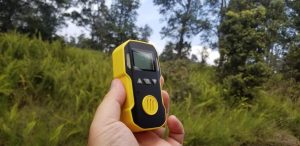
While the Kahuku Unit is far away from the seismic damage happening at the core of the park, it hasn’t completely been spared from volcanic problems. Unhealthy levels of sulfur dioxide (SO2) gas rising from the eruption site in Puna often travel to the area Kahuku is in, bringing a hazy vog to the park. Deacy told us if SO2 exists at levels over 1ppm for over 1.5 hours, portions of the Kahuku Unit or the entire park could close due to safety concerns. While that hasn’t happened yet, vog and SO2 levels were almost high enough to close portions of the park prior to the Coffee Talk event. Fortunately, just enough atmospheric mixing occurred to move the SO2 haze out of the area.
As the only portion of Hawaii Volcanoes National Park open, Rangers at the Coffee Talk unit were eager to welcome guests to explore the scenic trails there. Kahuku is open Wednesday through Sunday, 9am to 3pm., and offers free guided hikes, special programs, and frequent Hawaiian cultural workshops. Admission is free.
